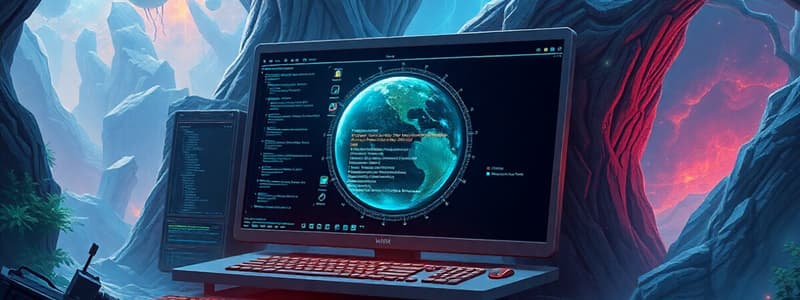Podcast
Questions and Answers
Which of the following statements is true about Windows in comparison to Linux Network Operating Systems?
Which of the following statements is true about Windows in comparison to Linux Network Operating Systems?
- Linux is more user-friendly
- Windows is open-source
- Linux has a modular design (correct)
- Windows is based on UNIX
What does the acronym FAT32 represent in file systems?
What does the acronym FAT32 represent in file systems?
- File Allocation Type 32-bit
- File Array Table 32-bit
- File Allocation Table 32-bit (correct)
- File Allocation Table 16-bit
Which component of an operating system is responsible for managing the directory structure of files?
Which component of an operating system is responsible for managing the directory structure of files?
- Kernel
- User Interface
- File System (correct)
- Device Manager
What is the primary function of a client in a client-server model?
What is the primary function of a client in a client-server model?
Which feature is NOT typically associated with a Network Operating System?
Which feature is NOT typically associated with a Network Operating System?
What characterizes the main focus of a desktop operating system?
What characterizes the main focus of a desktop operating system?
Which operating system was developed in the late 1960s and is still influential today?
Which operating system was developed in the late 1960s and is still influential today?
Which file system is known for supporting larger partition sizes and providing enhanced security?
Which file system is known for supporting larger partition sizes and providing enhanced security?
What is the maximum file size capacity of the FAT32 file system?
What is the maximum file size capacity of the FAT32 file system?
Which type of file system supports partition sizes up to 2 TB?
Which type of file system supports partition sizes up to 2 TB?
What is the role of the Kernel in an operating system?
What is the role of the Kernel in an operating system?
What feature distinguishes Network Operating Systems from other operating systems?
What feature distinguishes Network Operating Systems from other operating systems?
Which operating system is an example of an open-source system?
Which operating system is an example of an open-source system?
What does GUI stand for in computing?
What does GUI stand for in computing?
Which system type primarily focuses on user interaction through text commands?
Which system type primarily focuses on user interaction through text commands?
What kind of tasks does the kernel perform in an operating system?
What kind of tasks does the kernel perform in an operating system?
Flashcards
Multitasking
Multitasking
A technology that allows a computer to run multiple programs concurrently by dividing processing time between them.
Kernel
Kernel
The core part of an operating system, responsible for managing the computer's resources such as memory, processors, and peripherals.
Operating system
Operating system
A system software program that manages a computer's hardware and software resources, providing a user interface for interacting with the system.
Network operating system
Network operating system
Signup and view all the flashcards
NTFS
NTFS
Signup and view all the flashcards
FAT32
FAT32
Signup and view all the flashcards
Desktop operating system
Desktop operating system
Signup and view all the flashcards
Server
Server
Signup and view all the flashcards
What is the Kernel?
What is the Kernel?
Signup and view all the flashcards
What is FAT32?
What is FAT32?
Signup and view all the flashcards
What is a Network Operating System?
What is a Network Operating System?
Signup and view all the flashcards
What's GUI?
What's GUI?
Signup and view all the flashcards
What's CLI?
What's CLI?
Signup and view all the flashcards
What's a desktop OS?
What's a desktop OS?
Signup and view all the flashcards
What's a client-server model?
What's a client-server model?
Signup and view all the flashcards
What's UNIX?
What's UNIX?
Signup and view all the flashcards
Study Notes
Operating System Concepts
- Kernel: The core of an operating system, managing hardware and software resources.
- File System: Organizes files and directories on storage devices. FAT32 supports partitions up to 2TB, NTFS supports partitions up to 16 exabytes, & EXT4 is another file system option.
- User Interface (UI): The way users interact with the operating system. GUI (Graphical User Interface) is a common method, contrasted with CLI (Command Line Interface).
- Network Operating System (NOS): Designed for multi-user capability and networking features, allowing multiple users on a system to share resources.
- Client-Server Model: Servers respond to client requests, crucial for NOS environments.
Operating Systems Examples
- Windows 10/Server 2022: A common desktop and network operating system.
- Red Hat Linux: A popular open-source example of a network operating system.
- Mac OS: macOS is a proprietary operating system used by Apple.
- Android: A mobile OS used on various devices.
- Linux: An open-source example of a desktop operating system with a modular design.
- UNIX: An older but still influential family of operating systems that serve as a basis for many systems today.
Specific File System Details
- FAT32: Used in older systems, has a maximum file size of 4GB.
- NTFS: Supports much larger partitions and files than FAT32
- EXT3 & EXT4 & NTFS: Common file systems that handle larger partitions well.
Kernel Function
- Manages hardware and software resources: Allocating resources effectively.
- Provides a structure for users: Organising the interaction with the system.
Additional Q&A Information
-
GUI: Graphical user interface for easy user interaction.
-
CLI: Command-line interface for more advanced user interaction.
-
Multitasking: The ability of an OS to perform multiple tasks simultaneously.
Studying That Suits You
Use AI to generate personalized quizzes and flashcards to suit your learning preferences.




